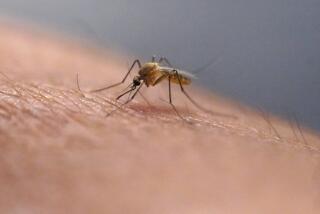Deborah Asnis dies at 59; helped detect West Nile virus in U.S.
Late in the summer of 1999, Dr. Deborah Asnis had three patients in Flushing Hospital in New York who had similar, dire symptoms and were not responding to treatment.
The patients had three things in common: all were from the same part of Queens, were 60 or older, and had dark tans. It was that last clue that eventually unlocked the mystery, leading to the diagnosis of the first known West Nile virus cases in the country.
It was the kind of situation that Asnis, chief of infectious diseases at the hospital, had trained for.
“I found infectious diseases to be fascinating,” she said in a 1999 New York Daily News interview. “It was challenging and intellectual, like a mystery that you have to solve.”
Asnis, 59, died Sept. 12 at Memorial Sloan Kettering Cancer Center in New York. The cause was breast cancer, said her son, Joshua Kazdin.
The medical mystery began when a man who lived in Queens was admitted to Flushing Hospital with a high fever and signs of delirium. Within a few days, he was so weak he couldn’t lift his arms. Before long, additional patients arrived with similar symptoms.
Asnis thought the cause might be a virus that hit the area, but antiviral drugs didn’t help. Other causes she considered included Guillain-Barre syndrome or botulism, but those didn’t quite fit the symptoms she was seeing.
She sounded the alarm, calling the city’s Bureau of Communicable Diseases, which in turn notified the Centers for Disease Control and Prevention. Asnis kept doing tests on patients, sending blood samples and spinal fluid packed in dry ice to a state lab.
More local people with similar symptoms were admitted. “It almost came to the point where if you showed up in the hospital with a 104-degree fever and a headache, you got a spinal tap,” Asnis told the Daily News.
Patients grew steadily worse, with some needing respirators to breathe, the Associated Press reported. Investigators, including Marci Layton of the city health department, came to the hospital to talk to the families, looking for clues.
The fact that they many were tanned indicated they spent a lot of time outdoors during the summer, and as it turned out, several loved to garden. Could the cause be a virus carried by mosquitoes?
“Marci Layton said that first,” Asnis said in an interview with Newsday.
An entomologist sent to the neighborhood found that stagnant ponds and even liquid in discarded beer cans had become vibrant breeding grounds for the insects in a summer with less rain than usual. The mosquito-borne disease was identified, wrongly as it turned out, as St. Louis encephalitis.
With some patients dying and word of the disease spreading, Mayor Rudolph Giuliani announced measures were being taken, including malathion insecticide spraying from helicopters. The onset of cooler weather also helped wipe out the disease-carrying mosquitoes.
In late September it was finally determined that the actual disease was West Nile virus, also carried by the insects.
Asnis’ quick actions in identifying and reporting the mysterious “cluster” of patients with serious symptoms was credited with keeping the outbreak from being worse.
She was born July 17, 1956, in New Hyde Park on Long Island and graduated from Roslyn High School. Asnis went to Northwestern University for her undergraduate and medical degrees.
The medical profession ran in the family — her father was a dentist and two older brothers became physicians. But Asnis’ inspiration was her mother, Ruth.
“She was an accountancy teacher, but we called her ‘Doctor Mom,’” Deborah Asnis told the Daily News in the 1999 interview. “She wanted me to pursue a career that I could use to be independent.”
Ruth Asnis died on Friday.
Deborah Asnis is survived by her husband, Dr. Hal Kazdin; sons Joshua and Matthew Kazdin; and brother Dr. Gregory Asnis.
More to Read
Start your day right
Sign up for Essential California for the L.A. Times biggest news, features and recommendations in your inbox six days a week.
You may occasionally receive promotional content from the Los Angeles Times.







